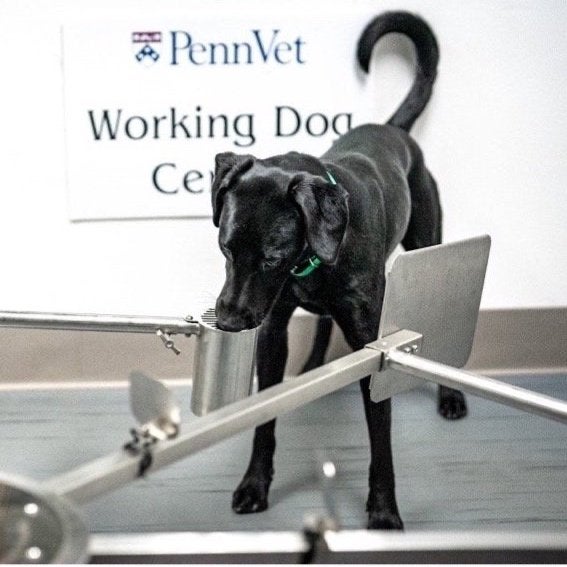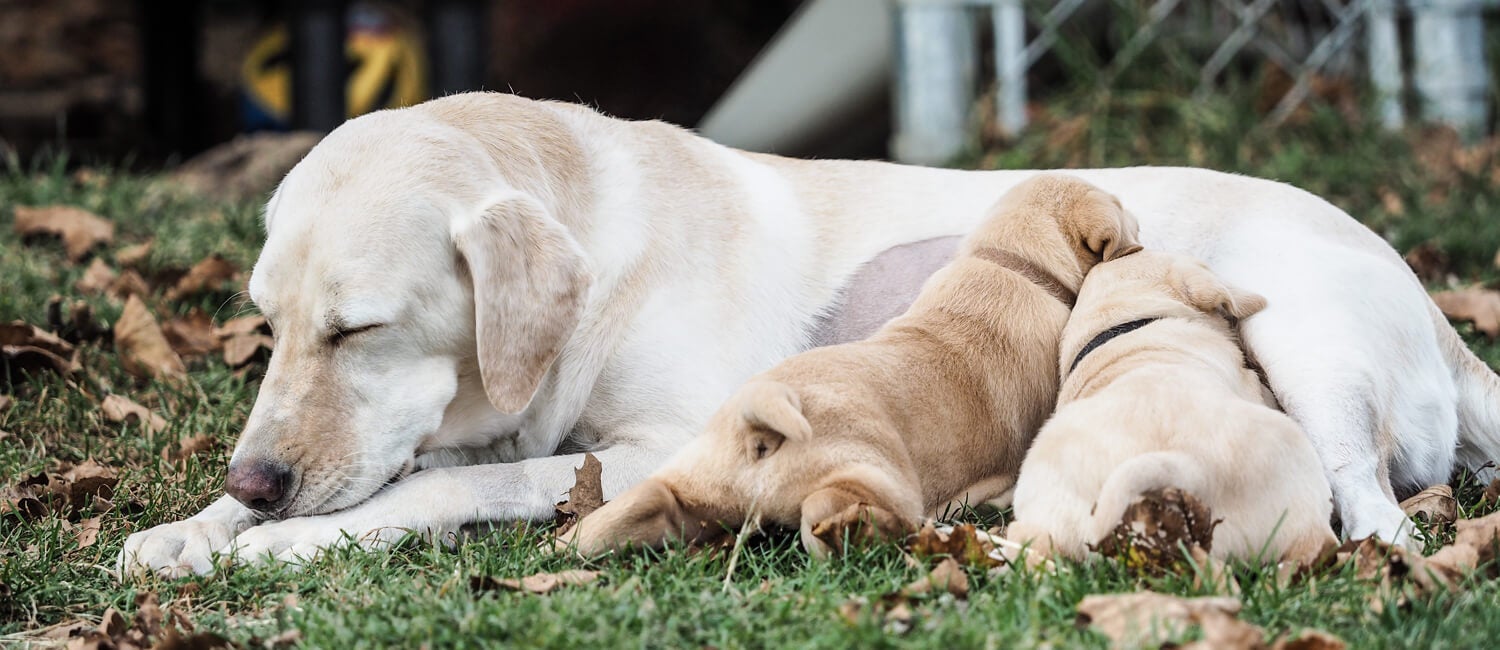Research
Working Dog Research
Our comprehensive research program leverages the expertise of our team and our collaborators to optimize the health and performance of detection dogs. The Center serves as a resource for investigating important research questions raised by the working dog community.
If you are interested in a sponsored research project or collaborating on a study, please contact us at wdcinfo@vet.upenn.edu.
Our main areas of research include:
- Sports & Performance Medicine
- Occupational Hazards
- Hydration
- Olfaction
- Cognition & Development

Every Two Minutes a Dog Dies of Hemangiosarcoma
We are training dogs to differentiate blood samples from healthy dogs versus dogs diagnosed with hemangiosarcoma. This research will bring us closer to earlier diagnositic tools that create more opportunities for intervention.
“Hemangiosarcoma is an insidious disease, taking the lives of dogs every two minutes. That’s why we are proud to support research focused on early detection. The Penn Vet Working Dog Center’s groundbreaking project-using dogs trained to detect volatile odor compounds from identified hemangiosarcoma blood samples-holds great promise in developing a much-needed tool for earlier diagnosis.”
Diane Mehra, Director, American German Shepherd Dog Charitable Foundation
Breeding Program
Our program is dedicated to optimizing the balance between nature (genetics) and nurture (the raising and training environment). By selecting for traits that align with successful detection work, we ensure that every dog has the foundation to thrive. Our approach recognizes each dog’s unique abilities, guiding them toward detection careers that match their individual strengths. Thanks to this philosophy, puppies entering our program achieve a remarkable graduation rate of over 94 percent!

Our Litters
| Year | Breeding |
|---|---|
| 2024 | Qwick (Vom Eisenraben/PVWDC) X Blitz (Vom Diamond) – January 2024 |
| 2023 | Groot (Kaiser K9) x Urban (WDC) — March 2023 |
| 2021 | Pinto (TSA/WDC) x Oso (Arizona Task Force One) — January 2021 |
| 2019 | Pinto (TSA/WDC) x Boomer (WDC/Puppies Behind Bars) — September 2019 |
| 2018 | Pacy (WDC) x Pete (Puppies Behind Bars) — April 2018 |
| 2017 | Ffoster (TSA) x Pancho (Deep Run Farms) — September 2017 |
| 2017 | Socks (WDC) x Pete (Puppies Behind Bars) — June 2017 |
| 2017 | Felony (WDC) x Hector (Vrijheid Dutch Shepherds) — May 2017 |
| 2016 | Pacy (WDC) x Packer (TSA/WDC) — July 2016 |
| 2016 | Socks (WDC) x Ddolan (TSA) — June 2016 |
| 2014 | Zzisa (TSA) x Ffisher (TSA) — June 2014 |
| 2015 | Ffoster (TSA) x DaVinci (CCI) — June 2015 |
Publications
Retrospective evaluation and review of approaches for nonspecific lameness in dogs presented to an emergency service (2013–2014): 134 cases. Ramos, M. T., Hartzell, A. M., & Otto, C. M. (2024). Journal of Veterinary Emergency and Critical Care, 34(1), 81-88.
Functional measurement of canine muscular fitness: refinement and reliability of the Penn Vet Working Dog Center Sprint Test. Farr, B., Gabrysiak, J., Traylor, R., Zayas, S., Ramos, M., Mallikarjun, A., & Otto, C. (2023). Frontiers in Veterinary Science, 10. DOI:10.3389/fvets.2023.1217201
Rehabilitation to Return-to-Work for Working Dogs. Ramos, M. T., Farr, B. D., & Otto, C. M. (2023). Veterinary Clinics: Small Animal Practice, 53(4), 869-878. DOI: https://doi.org/10.1016/j.cvsm.2023.02.014
The Effects of Fitness Training on Working Dog Behavior: Two Case Studies. Wilson, C., Ebbecke, D., Berger, D., & Otto, C. (2023). Veterinary Clinics: Small Animal Practice. DOI: https://doi.org/10.1016/j.cvsm.2023.08.005
Canine mobility maintenance and promotion of a healthy lifestyle. Ramos, M. T., & Otto, C. M. (2022). Veterinary Clinics of North America: Small Animal Practice, 52(4), 907-924. DOI:10.1016/j.cvsm.2022.03.001
A Randomized, Blinded, Placebo‐Controlled Crossover Study of the Pharmacokinetics and Pharmacodynamics of Naloxone, Naltrexone, and Nalmefene in Methadone‐Sedated Working Dogs. Mills, T., Robinson, M.A., Barr, C., Stefanovski, D., You, Y., Proctor, R., Seizova, K., Mallikarjun, A. and Otto, C.M., 2025. Journal of Veterinary Pharmacology and Therapeutics.
Voluntary head dunking after exercise-induced hyperthermia rapidly reduces core body temperature in dogs. Parnes, S. C., Mallikarjun, A., Ramos, M. T., Capparell, T. R., & Otto, C. M. (2024). Journal of the American Veterinary Medical Association, 1(aop), 1-9. https://doi.org/10.2460/javma.24.06.0368
A 15-year longitudinal study of search-and-rescue dogs identifies the musculoskeletal, integumentary, and gastrointestinal systems as commonly affected. Seeley AC, Isaksen KE, Lucas A, Cogger N, Otto CM. JAVMA 2023. doi.org/10.2460/javma.23.08.0439
Pharmacokinetics and Pharmacodynamics of Intranasal and Intramuscular Naloxone in Working Dogs Administered Fentanyl, Barr C, Haughan J, Giacomo G, Varner K, Drobatz K, Stefanovski D, Robinson MA, Pennington M, McGuire A, Otto, CM. , J Vet Int Med J Vet Int Med 2023: 1-7. https://onlinelibrary.wiley.com/doi/10.1111/jvim.16901
Long-term behavioral resilience in search-and-rescue dogs responding to the September 11, 2001 terrorist attacks. Hare, E., Kelsey, K. M., Niedermeyer, G. M., & Otto, C. M. (2021). Applied Animal Behaviour Science, 234, 105173. DOI: https://doi.org/10.1016/j.applanim.2020.105173
Behavior traits associated with career outcome in a prison puppy-raising program. Hare, E., Joffe, E., Wilson, C., Serpell, J., & Otto, C. M. (2021). Applied Animal Behaviour Science, 236, 105218. DOI:https://doi.org/10.1016/j.applanim.2021.105218
Fifteen-year surveillance of pathological findings associated with death or euthanasia in search-and-rescue dogs deployed to the September 11, 2001, terrorist attack sites. Otto, C. M., Hare, E., Buchweitz, J. P., Kelsey, K. M., & Fitzgerald, S. D. (2020). Journal of the American Veterinary Medical Association, 257(7), 734-743. DOI: https://doi.org/10.2460/javma.257.7.734
A randomized cross-over field study of pre-hydration strategies in dogs tracking in hot environments. Niedermeyer, G. M., Hare, E., Brunker, L. K., Berk, R. A., Kelsey, K. M., Darling, T. A., … & Otto, C. M. (2020). Frontiers in Veterinary Science, 292. DOI: https://doi.org/10.3389/fvets.2020.00292
Wilson, C., Buis, M., Mallikarjun, A., & Otto, C. M. (2025). Running track length affects repeatability of sprint test results in working dogs. American Journal of Veterinary Research, 1, 1-7.
Mallikarjun, A., Wilson, C., Charendoff, I., Moore, M.B., Nguyen, E., Hendrzak, A.J., Gibison, M. and Otto, C.M., 2025. Dogs Can Generalize from Cotton Training Aids to Fecal Matter in Chronic Wasting Disease Detection. Journal of Wildlife Diseases.
Ramos, M. T., Chang, G., Wilson, C., Gilbertie, J., Krieg, J., Parvizi, J., … & Schaer, T. P. (2024). Dogs can detect an odor profile associated with Staphylococcus aureus biofilms in cultures and biological samples. Frontiers in Allergy, 5, 1275397.
Assessing Different Chronic Wasting Disease Training Aids for Use with Detection Dogs. Mallikarjun, A., Charendoff, I., Moore, M. B., Wilson, C., Nguyen, E., Hendrzak, A. J., … & Otto, C. M. (2024). Animals, 14(2), 300. https://www.mdpi.com/2076-2615/11/7/1978
The promise of disease detection dogs in pandemic response: lessons learned from COVID-19. Otto, C. M., Sell, T. K., Veenema, T. G., Hosangadi, D., Vahey, R. A., Connell, N. D., & Privor-Dumm, L. (2023). Disaster medicine and public health preparedness, 17, e20. DOI:10.1017/dmp.2021.183
Canine detection of chronic wasting disease (CWD) in laboratory and field settings. Mallikarjun, A., Swartz, B., Kane, S. A., Gibison, M., Wilson, I., Collins, A., … & Otto, C. M. (2023). Prion, 17(1), 16-28. DOI:https://www.tandfonline.com/doi/full/10.1080/19336896.2023.2169519
Canine scent detection of sinonasal-inverted papilloma in blood plasma and nasal secretions. Mallikarjun, A., Collins, A., Verta, A., Hanadari-Levy, A., Chaskes, M. B., Rosen, M. R., … & Otto, C. M. (2023). Journal of Veterinary Behavior, 62, 29-38. DOI:https://doi.org/10.1016/j.jveb.2023.02.008
Expert considerations and consensus for using dogs to detect human SARS-CoV-2-infections. Meller, S., Al Khatri, M. S. A., Alhammadi, H. K., Álvarez, G., Alvergnat, G., Alves, L. C., … & Volk, H. A. (2022). Frontiers in medicine, 9, 3590. DOI:https://doi.org/10.3389/fmed.2022.1015620
The use of biological sensors and instrumental analysis to discriminate COVID-19 odor signatures. Gokool, V. A., Crespo-Cajigas, J., Mallikarjun, A., Collins, A., Kane, S. A., Plymouth, V., … & Otto, C. M. (2022). Biosensors, 12(11), 1003. DOI:https://www.mdpi.com/2079-6374/12/11/1003
Effects of Intranasal and Oral Bordetella bronchiseptica Vaccination on the Behavioral and Olfactory Capabilities of Detection Dogs. Collins, A., Bear, R. A., Mallikarjun, A., Kane, S. A., Essler, J. L., Kaynaroglu, P., … & Otto, C. M. (2022). Frontiers in Veterinary Science, 9, 882424. DOI:https://doi.org/10.3389/fvets.2022.882424
Canine discrimination of ovarian cancer through volatile organic compounds. Kane, S. A., Lee, Y. E., Essler, J. L., Mallikarjun, A., Preti, G., Verta, A., … & Otto, C. M. (2022). Talanta, 250, 123729. DOI:https://doi.org/10.1016/j.talanta.2022.123729
The first responder exposure to contaminating powder on dog fur during intranasal and intramuscular naloxone administration. Essler, J. L., Smith, P. G., Ruge, C. E., Darling, T. A., Barr, C. A., & Otto, C. M. (2022). Journal of Veterinary Emergency and Critical Care, 32(1), 18-25. DOI:https://doi.org/10.1111/vec.13113
The animal welfare science of working dogs: current perspectives on recent advances and future directions. Cobb, M. L., Otto, C. M., & Fine, A. H. (2021). Frontiers in veterinary science, 1116. DOI:10.3389/fvets.2021.666898
Working dog training for the twenty-first century. Hall, N. J., Johnston, A. M., Bray, E. E., Otto, C. M., MacLean, E. L., & Udell, M. A. (2021). Frontiers in veterinary science, 834. DOI:https://doi.org/10.3389/fvets.2021.646022
Working Dogs: Form and Function, Volume II. Hall, N. J., Otto, C. M., & Baltzer, W. I. (2021). Frontiers in Veterinary Science, 858. DOI:https://doi.org/10.3389/fvets.2021.732304
Discrimination of SARS-CoV-2 infected patient samples by detection dogs: a proof of concept study. Essler, J. L., Kane, S. A., Nolan, P., Akaho, E. H., Berna, A. Z., DeAngelo, A., … & Otto, C. M. (2021). PLoS One, 16(4), e0250158. DOI:https://doi.org/10.1371/journal.pone.0250158
Egg masses as training aids for spotted lanternfly Lycorma delicatula detection dogs. Essler, J. L., Kane, S. A., Collins, A., Ryder, K., DeAngelo, A., Kaynaroglu, P., & Otto, C. M. (2021). PLoS One, 16(5), e0250945. DOI:https://doi.org/10.1371/journal.pone.0250945
Expert perspectives on the performance of explosive detection canines: operational requirements. Farr, B. D., Otto, C. M., & Szymczak, J. E. (2021). Animals, 11(7), 1976. DOI:https://www.mdpi.com/2076-2615/11/7/1978
Guest, C., & Otto, C. M. (2020). Frontiers in Veterinary Science, 7, 100. DOI:https://doi.org/10.3389/fvets.2020.00100
An assessment of the stability of the canine oral microbiota after probiotic administration in healthy dogs over time. Bell, S. E., Nash, A. K., Zanghi, B. M., Otto, C. M., & Perry, E. B. (2020). Frontiers in Veterinary Science, 7, 616. DOI:https://doi.org/10.3389/fvets.2020.00616
Exploring ovarian cancer screening using a combined sensor approach: A pilot study. Kybert, N., Prokop-Prigge, K., Otto, C. M., Ramirez, L., Joffe, E., Tanyi, J., … & Preti, G. (2020). AIP Advances, 10(3). DOI:https://pubs.aip.org/aip/adv/article/10/3/035213/1037477/Exploring-ovarian-cancer-screening-using-a
Machine learning prediction and classification of behavioral selection in a canine olfactory detection program. Eyre, A. W., Zapata, I., Hare, E., Serpell, J. A., Otto, C. M., & Alvarez, C. E. (2023). Scientific Reports, 13(1), 12489. DOI: https://doi.org/10.1038/s41598-023-39112-7
Enhancing the selection and performance of working dogs. Bray, E. E., Otto, C. M., Udell, M. A., Hall, N. J., Johnston, A. M., & MacLean, E. L. (2021). Frontiers in veterinary science, 430. DOI: https://doi.org/10.3389/fvets.2021.644431
Differences in the search behavior of cancer detection dogs trained to have either a sit or stand-stare final response. Essler, J. L., Wilson, C., Verta, A. C., Feuer, R., & Otto, C. M. (2020). Frontiers in Veterinary Science, 7, 118. DOI: https://doi.org/10.3389/fvets.2020.00118
Penn Vet Working Dog Center
Follow PVWDC:
3401 Grays Ferry Ave., Bldg. 470, Philadelphia, PA 19146
